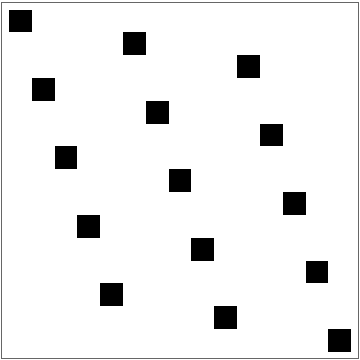Wolfram Function Repository
Instant-use add-on functions for the Wolfram Language
Function Repository Resource:
Generate a commutation matrix
ResourceFunction["CommutationMatrix"][m,n] returns the commutation matrix . |
A commutation matrix:
| In[1]:= |
| Out[1]= |
Visualize the commutation matrix:
| In[2]:= |
| Out[2]= |  |
Return the commutation matrix as a dense matrix:
| In[3]:= |
| Out[3]= |
Return the commutation matrix as a structured array:
| In[4]:= |
| Out[4]= |
Return the commutation matrix as a sparse array:
| In[5]:= |
| Out[5]= |
Specify the working precision for the commutation matrix:
| In[6]:= |
| Out[6]= |
The normal representation returns a full matrix with finite precision elements:
| In[7]:= |
| Out[7]= |
The commutation matrix is orthogonal, i.e. the inverse is equal to the transpose:
| In[8]:= | ![p = 4; q = 3;
cm = ResourceFunction["CommutationMatrix"][p, q];
Inverse[cm] === Transpose[cm]](https://www.wolframcloud.com/obj/resourcesystem/images/473/4738deb1-6732-47cc-b4d7-0ace565aff71/1804a26f15952682.png) |
| Out[10]= |
The inverse of CommutationMatrix[p,q] is given by CommutationMatrix[q,p]:
| In[11]:= |
| Out[12]= |
Define the vec operator, which stacks the columns of a matrix into a single vector:
| In[13]:= |
The commutation matrix relates the result of applying the vec operator to a matrix and its transpose:
| In[14]:= | ![p = 4; q = 3;
m1 = Array[\[FormalX], {p, q}];
vec[Transpose[m1]] == ResourceFunction["CommutationMatrix"][p, q] . vec[m1]](https://www.wolframcloud.com/obj/resourcesystem/images/473/4738deb1-6732-47cc-b4d7-0ace565aff71/153a9d0f4299b118.png) |
| Out[15]= |
The commutation matrix can be used to express the relationship between the Kronecker product of two given matrices and the Kronecker product of the same matrices in reverse order:
| In[16]:= | ![p = 4; q = 3;
m1 = Array[\[FormalX], {p, q}];
r = 4; s = 3;
m2 = Array[\[FormalY], {r, s}];
KroneckerProduct[m1, m2] . ResourceFunction["CommutationMatrix"][q, s] == ResourceFunction["CommutationMatrix"][p, r] . KroneckerProduct[m2, m1]](https://www.wolframcloud.com/obj/resourcesystem/images/473/4738deb1-6732-47cc-b4d7-0ace565aff71/1b76c210dcc19259.png) |
| Out[17]= |
The commutation matrix can be expressed as a sum of Kronecker products of an identity matrix with unit vectors:
| In[18]:= | ![p = 4; q = 3;
ResourceFunction["CommutationMatrix"][p, q] == \!\(
\*UnderoverscriptBox[\(\[Sum]\), \(k = 1\), \(p\)]\(KroneckerProduct[
UnitVector[p, k], IdentityMatrix[q], UnitVector[p, k]]\)\)](https://www.wolframcloud.com/obj/resourcesystem/images/473/4738deb1-6732-47cc-b4d7-0ace565aff71/54df9d8996905ceb.png) |
| Out[19]= |
Wolfram Language 13.1 (June 2022) or above
This work is licensed under a Creative Commons Attribution 4.0 International License